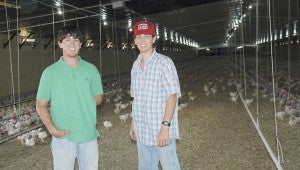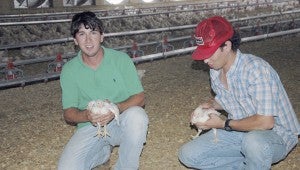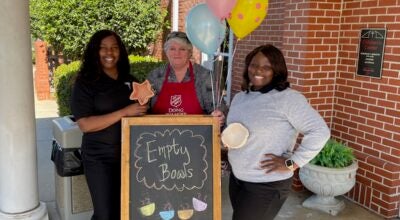‘IN THE BUSINESS’: Local poultry farmers vow ‘no antibiotics ever’
Published 2:00 am Saturday, July 18, 2015

MESSENGER PHOTO/JAINE TREADWELL
Halston Motes, left, and his friend, Austin Adler stand in a chicken house with about a football field’s length worth of chickens behind them
Halston G. Motes and his friend, Austin Adler, walk with the swagger of Super Bowl champions.
That kind of swagger might not be expected of young poultry farmers but it’s there.
Motes is confident in his mega buck investment in a Mega House Poultry Farm. Adler is confident in his friend and in their commitment to operate a successful poultry farm.
Motes, 22, has been around the “chicken business” almost all his life. His grandparents, James and Elizabeth Motes, have poultry houses along with cattle and field production, so his decision to go into farming didn’t just come out of the blue.
“I’ve been around farming for as long as I can remember,” Motes said. “I got started in farming six years ago with row crops. That’s how I met Austin. He was looking for work. I needed help with my crops and he was good help. I have corn, soybeans, hay and cows, so poultry farming fits into the kind of lifestyle that appeals to me.
“And, too, with poultry farming you don’t have to worry much about the weather. Poultry farming is more stable than row crops, and you can pretty much count on a pay check coming in.”
Motes, laughingly, said if people could control the weather there would be a lot more farmers.
“With poultry farming these days, you can control the weather to a large degree,” he said. Motes has invested in two Mega Poultry Houses and is a grower for Wayne Farms.
To demonstrate the “mega” of the houses, Motes and Adler stood facing each other, Motes on one side of the “fence” that divided the 60×600-foot Mega House and Adler on the other.
“It’s a football field on each side of the house,” Motes said as he gestured toward the end zone of the house behind him. “This was quite an investment for me. It’s something I gave a lot of thought to, but it’s not anything that I’m worrying about. The conditions in these Mega Houses are just about as perfect as you can get in poultry farming. I work hard, and I’ve got a good, dependable and hardworking friend right along with me. This is exactly what I want to be doing.”
Motes and Adler are playing mother hen to 33,600 birds in each of the two houses.
“That’s a lot of chickens,” Motes said with a smile. “They are four weeks old now and, in another three weeks, you won’t be able to see the floor for all the chickens. We’ll grow eight and half-pound birds in eight weeks, then we’ll be without chickens for 12 to 14 days and then right back in the chicken business.”
Motes and Adler take great pride in that the chickens they grow are grown without any antibiotics.
“These birds receive no medication,” Adler said. “They are grown with NAE, No Antibiotics Ever. That’s the kind of chicken that people want to eat.”
Although, it would seem that without medication, the birds would be more prone to sicknesses, but that’s not the case.
“The health of the chickens is all about their diet and their comfort, ” Motes said. “With these Mega Houses, there’s a science to everything — from the feed they eat and the water they drink to their comfort. Their feed and water are controlled so that they get exactly the right amount for their age and weight. The temperature and the lighting have been gotten down to a science as well. If you keep the stress off the birds and keep them comfortable, they will be healthy birds.
“Everything in here is perfect for growing healthy chickens without antibiotics.”
Computers regulate the conditions in the house and also alert the grower to any problems that arise.
“Halston and I are in and out of the houses all day every day,” Adler said. “One of us is here all the time. These poultry houses are our recreation. They are our beaches. We want to make sure we’re on top of everything, every day and all the time.”
Motes said the Mega Houses are built to withstand the elements.
“The walls are solid and well insulated,” he said. “If a storm comes, we are as prepared as we can be. If there’s a power failure, we’ve got generators and backup generators for those. You can never be too prepared. There’s a lot riding on these birds. We’re learning as we go and working hard and doing all we can to be successful.”
Adler, 20, attends Troy University and is seriously considering owning his own poultry farm in the not too distant future.
“I’m learning a lot from Halston and from his granddad,” Adler said. “Halston told me that you don’t go into this kind of business thinking you’ll get rich. He said you go into it to make a living and, if you have any hesitation, don’t do it. Right now, I’m thinking seriously about it.”
The young poultry farmers said they have no reservations or concerns about friends being “in business” together.
“We trust each other and appreciate each other, because we both work hard,” Adler said. “We’re good friends, and that makes working together even better.”
The good friends also grow corn and soybeans. The corn is sold for chicken feed so it comes back to them in a sense. They bale hay and tend a herd of cows.
“This is the lifestyle for me,” Motes said. “I love being on the farm and I love what I’m doing. I can’t think of a more rewarding job for me than farming.”
Not many young 20-somethings know exactly what they want to do with their lives. Motes has no doubt. Adler isn’t quite sure just yet. But, both are confident in what they are doing, and that’s reason enough for them to walk with a bit of swagger.




